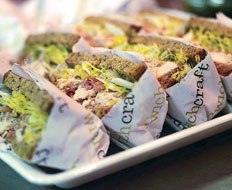The seasoning of the food, impeccable service, crisp table linens—every detail counts in fine dining, as chefs and managers seek to create a memorable experience alongside a savory meal.
That same strategy is now playing out in the quick-serve arena, where fine-dining operators are increasingly creating fast-casual sister concepts to their white-tablecloth businesses.
Thomas Salamunovich is among the growing group of operators taking full-service and fine-dining concepts into quick service to complement their original brands and to compete for a new customer base. He and other fine-dining veterans say they’re able to make the move by focusing on quality ingredients and maintaining the integrity of their cooking.
Salamunovich, a classically trained chef, now owns seven Larkburger stores in Colorado. The concept serves all-natural gourmet burgers, fries, and shakes and is named after his fine-dining establishment, Larkspur Restaurant in Vail, Colorado.
He created the new concept because he wasn’t finding enough fast-casual restaurants where he could eat with his family, and he realized the gourmet burger already on his menu could stand on its own if he protected the quality of the original dish.
“In cooking, it’s about bringing integrity and passion. It’s inconsequential what the refinement of the dining experience is,” Salamunovich says. “I care as much about the ground beef hamburger as I do cooking foie gras or caviar.”
Hints of fine dining are found across Larkburger’s menu. The fries are hand cut and each location has a so-called “french fry whisperer” to oversee quality. Fries topped with white truffle oil, truffle salt, and Parmesan cheese are more popular than plain fries. The 1⁄3-pound Angus burger, topped with a savory aioli, leaf lettuce, tomato, and red onion goes for about $6, and the average Larkburger ticket is between $8 and $9.
With those kinds of prices, Salamunovich thinks he can capture customers—many of whom are vacationing in Colorado—more often than he could with just a fine-dining restaurant.
Though his burger stores do about one-fifth the business of his fine-dining restaurant, Salamunovich says opening a new quick serve costs about $450,000, while a fine-dining restaurant can cost upward of $4 million. And the simplicity of quick-service concepts makes them easier to operate. Larkburger’s kitchens have an inventory of about 150 items; Larkspur has about 14,000.
That same simplicity and focus on quality has proven successful for ’wichcraft, a quick-service sandwich chain opened by chef Tom Colicchio, the head judge of Bravo’s “Top Chef” who was already running the successful Craft family of restaurants.
Carrying such a concept over into one quick-serve store is fairly simple, says ’wichcraft president and CEO Jeffrey Zurofsky, but maintaining that quality across 15 locations is tricky. Attaching the name of a well-known celebrity chef to a chain of quick serves also places high pressure and high expectations on such ventures, he says. “The food is really the key to doing it,” Zurofsky says. “That’s why they’re trusting the chef.”
Turkeys for the turkey sandwich are cooked the same way as those as ’wichcraft’s fine-dining sister restaurant, and the lemon confit on the tuna sandwich is prepared exactly the same way Colicchio has done it for 20 years. These familiar ingredients let diners experience more sophisticated dishes, but for less than $10.
Zurofsky says he views the sandwich shops as more stable because they don’t fluctuate with the economy the way more expensive full-service restaurants do.
Fine-dining restaurateur George Frangos, owner and operator of the two Atlanta-area Farm Burger restaurants, says he’s found an unintended benefit of venturing into the quick-service business. Because of his restaurants’ low prices, some customers are more likely to try unfamiliar items, like the company’s sustainable grass-fed burgers.
“They try it without a lot of risk when your average check is $10 and change,” he says. “It’s an opportunity to try something people have heard about without having to throw down 30 bucks for a grass-fed steak.”
By realizing savings on items like china, linens, and silverware, the quick-service restaurant is able to cover slightly higher food costs than a full-service restaurant, Frangos says. Those savings allow Farm Burger to replicate the integrity and quality of the food at its full-service sister restaurant, Farm 255, in Athens, Georgia. “We haven’t had to dumb down anything,” Frangos says. “We haven’t lost our values and commitment to food.”
Even chain restaurants as large as Red Robin and Ruby Tuesday have recently ventured into the quick-service market. Ruby Tuesday purchased the existing Florida-based Lime Fresh Mexican Grill, with plans to open six to eight more of the quick-service restaurants in the next year. Red Robin, meanwhile, developed two spin-off fast-casual restaurants called Burger Works.
The concept, which Red Robin plans to expand, has some of the same menu items as its full-service parent, but also has a build-your-own burger option. The small footprint and quicker service could open up development opportunities for Burger Works in more urban environments, college campuses, airports, and other nontraditional locations, says Jennifer Rivas, Red Robin’s director of national marketing.
Traditionally, Red Robin stores are located in more suburban areas and targeted to families. The new concept will open the door for new customers, Rivas says.
“We are excited to bring our brand and these burgers to guests that have not been available to us in the past,” she says. “The idea is to just bring the essence of Red Robin to our guests in a smaller, nontraditional prototype.”







